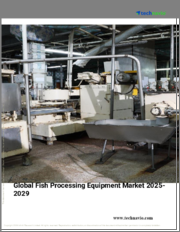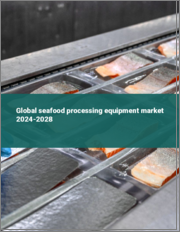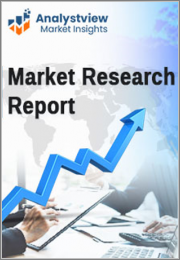
|
시장보고서
상품코드
1766072
세계의 수산 기계 제조 시장 예측 - 제품별, 조작 모드별, 동력원별, 장치별, 공정별, 최종사용자별, 지역별 분석(-2032년)Fishery Machinery Manufacturing Market Forecasts to 2032 - Global Analysis By Product, Operation Mode, Power Source, Equipment, Process, End User and By Geography |
||||||
Stratistics MRC에 따르면 세계 수산 기계 제조 시장은 2025년 121억 달러, 예측 기간 동안 CAGR 5.8%로 성장하고, 2032년에는 181억 달러에 이를 것으로 예측됩니다.
수산 기계 제조는 어업 및 양식 산업의 다양한 단계에서 사용되는 특수 장비의 설계, 생산 및 조립을 의미합니다. 운반기, 급식기, 에어레이터, 필레 가공기 등 내륙어업과 해양어업 모두에서 사용되는 기기도 이 섹터에 포함되어 있습니다.
가공 수산물 수요 증가
수산 가공품에 대한 수요 증가는 수산 기계 제조 시장의 성장을 크게 뒷받침하고 있습니다. 이러한 수요 급증은 충전, 가죽 벗기기, 냉동 및 포장을 위한 자동화 기계에 대한 투자를 장려합니다. 그 결과, 제조업체 각사는 진화하는 가공 요구에 대응하기 위해서 기술 혁신을 진행해, 시장 확대에 박차를 가해, 세계의 수산 가공 업계 전체에서 현대적인 어업 기계의 채택을 뒷받침하고 있습니다.
높은 초기 투자 비용
높은 초기 투자 비용은 수산 기계 제조 시장의 성장에 큰 장벽이 될 것입니다. 제적 부담은 시장 진입과 시장 확대를 제한하고, 기술 혁신을 늦추고, 경쟁력을 저하시킵니다.
기술 진보
기술 진보는 효율성, 정확성 및 지속가능성을 향상시켜 시장 성장을 가속화하고 있습니다. 이러한 인텔리전트 기술은 실시간으로 데이터 분석을 용이하게 하고 자원 관리와 의사결정을 개선합니다.
규제 과제
규제상의 과제는 어업기계 제조시장에 유해하고 저해적인 영향을 주고 있습니다. 국제 표준의 변동은 기업들이 전 세계로 확장하기 어렵게 만들어 시장 성장을 제한합니다. 또한 복잡한 승인 절차와 진화하는 법적 틀이 불확실성을 낳고, 이 분야에 대한 투자와 혁신의 의욕을 깎아 궁극적으로 기술 진보와 상업화의 페이스를 제한하고 있습니다.
COVID-19의 영향
COVID-19 팬데믹은 수산 기계 제조 시장에 다양한 영향을 미쳤습니다. 포장 및 냉동 된 수산물에 대한 수요가 증가함에 따라 시장은 점차 회복했습니다.
예측 기간 동안 해머 밀 부문이 최대가 될 전망
해머 밀 부문은 양식용 사료의 가공 효율을 높이기 때문에 예측 기간 동안 최대 시장 점유율을 차지할 것으로 예측됩니다. 이 기계들은 원료를 미세하고 균일한 입자로 분쇄하여 어류 양식에서 사료 소화율과 성장률을 향상시키는 데 필수적입니다. 견고한 설계와 에너지 효율이 높은 성능은 대용량 생산을 지원하고 수산물 수요 증가에 부응합니다.
수산 양식 분야는 예측 기간 동안 가장 높은 CAGR이 예상됩니다.
예측기간 동안 선진적, 효율적, 지속가능한 기계 수요로 인해 수산양식 분야가 가장 높은 성장률을 보일 것으로 예측됩니다. 이러한 성장은 제조업체들이 양식 수요에 맞춘 특수 기계를 혁신하고 생산하도록 촉진합니다. 또한 지속 가능한 양식에 대한 정부의 지원은 현대적인 어업 기계에 대한 투자를 더욱 촉진해, 양식장 전체의 생산성과 작업 효율을 높입니다.
최대 점유율이 있는 지역 :
예측 기간 동안 아시아태평양은 수산물 수요 증가, 어업 근대화에 대한 정부 지원, 양식 투자 증가로 시장 점유율이 가장 큰 것으로 예측됩니다. 중국, 인도, 일본과 같은 국가는 생산성을 높이고 노동력 의존성을 줄이기 위해 고급 어업 기계를 채택하고 있습니다. 또한 수출 증가와 혁신은 시장 확대에 박차를 가하고 있습니다. 이 지역의 광대한 해안선과 풍부한 해양 자원은 효율적이고 지속 가능한 어업 장비 솔루션의 필요성을 더욱 강화하고 있습니다.
CAGR이 가장 높은 지역 :
예측 기간 동안 북미는 자동화의 진전과 지속 가능한 어업에 대한 정부의 지원책에 의해 가장 높은 CAGR을 나타낼 것으로 예측됩니다. 고효율 장비를 채택하면 생산성이 향상되고 노동력에 대한 의존도가 낮아 대규모 상업 어업이 촉진됩니다. 또한 주요 제조업체의 존재와 강력한 기술 인프라는 수산 가공 및 양식 시스템의 혁신을 촉진하고, 지역 전체 시장 성장을 더욱 강화하고, 세계 수산물 무역에서 경쟁력을 확보합니다.
무료 맞춤형 서비스
이 보고서를 구독하는 고객은 다음 무료 맞춤설정 옵션 중 하나를 사용할 수 있습니다.
- 기업 프로파일
- 추가 기업의 종합적 프로파일링(3개사까지)
- 주요 기업의 SWOT 분석(3개사까지)
- 지역 구분
- 고객의 관심에 응한 주요국 시장 추정, 예측, CAGR(주 : 타당성 확인에 따름)
- 경쟁 벤치마킹
- 제품 포트폴리오, 지리적 존재, 전략적 제휴에 기반한 주요 기업 벤치마킹
목차
제1장 주요 요약
제2장 서론
- 개요
- 이해관계자
- 분석 범위
- 분석 방법
- 데이터 마이닝
- 데이터 분석
- 데이터 검증
- 분석 접근
- 분석 자료
- 1차 조사 자료
- 2차 조사 정보원
- 전제조건
제3장 시장 동향 분석
- 소개
- 성장 촉진요인
- 억제요인
- 시장 기회
- 위협
- 제품분석
- 최종 사용자 분석
- 신흥 시장
- 신형 코로나 바이러스 감염(COVID-19)의 영향
제4장 Porter's Five Forces 분석
- 공급자의 협상력
- 바이어의 협상력
- 대체 제품의 위협
- 신규 진출기업의 위협
- 기업간 경쟁
제5장 세계의 수산 기계 제조 시장 : 제품별
- 어군 감지기
- 낚시용 윈치
- 메시 운반기
- 급식 시스템
- 에어레이터
- 물 순환 장치
- 선별·등급 구분 기기
- 기타 제품
제6장 세계의 수산 기계 제조 시장 : 조작 모드별
- 수동
- 반자동
- 자동
제7장 세계의 수산 기계 제조 시장 : 동력원별
- 전기
- 디젤
- 태양광
- 하이브리드
제8장 세계의 수산 기계 제조 시장 : 장치별
- 소각로
- 클리핑 머신
- 내장 제거기
- 해머밀
- 스케일
- 스키너즈
- 랩 머신
- 기타 장치
제9장 세계의 수산 기계 제조 시장 : 공정별
- 세정
- 요리
- 건조
- 연삭
- 포장
- 필링
- 훈제
제10장 세계의 수산 기계 제조 시장 : 최종 사용자별
- 상업 어업
- 양식업
- 연구·모니터링
- 레크리에이션?낚시
- 기타 최종 사용자
제11장 세계의 수산 기계 제조 시장 :지역별
- 북미
- 미국
- 캐나다
- 멕시코
- 유럽
- 독일
- 영국
- 이탈리아
- 프랑스
- 스페인
- 기타 유럽
- 아시아태평양
- 일본
- 중국
- 인도
- 호주
- 뉴질랜드
- 한국
- 기타 아시아태평양
- 남미
- 아르헨티나
- 브라질
- 칠레
- 기타 남미
- 중동 및 아프리카
- 사우디아라비아
- 아랍에미리트(UAE)
- 카타르
- 남아프리카
- 기타 중동 및 아프리카
제12장 주요 발전
- 계약, 사업 제휴 및 협력, 합작 사업
- 기업 합병 및 인수(M&A)
- 신제품 발매
- 사업 확장
- 기타 주요 전략
제13장 기업 프로파일링
- AKVA Group
- Baader Group
- Marel Townsend Further Processing
- Skaginn 3X
- The Middleby Corporation
- Optimar AS
- Pisces Fish Machinery Inc.
- Uni-Food Technic A/S
- Cabinplant A/S
- Sludge Drying Equipment Co., Ltd.
- Zhenhua Machinery Co., Ltd.
- GEA Group AG
- Haarslev Industries
- JBT Corporation
- FTNON
- Bertuzzi Food Processing
- Laitram Machinery
- TECNOTRADE OY
According to Stratistics MRC, the Global Fishery Machinery Manufacturing Market is accounted for $12.1 billion in 2025 and is expected to reach $18.1 billion by 2032 growing at a CAGR of 5.8% during the forecast period. Fishery machinery manufacturing refers to the design, production, and assembly of specialized equipment used in various stages of the fishing and aquaculture industries. This includes machines for fish harvesting, processing, feeding, grading, cleaning, packaging, and storage. The sector also covers equipment used in both inland and marine fisheries, such as trawl systems, net haulers, feeders, aerators, and filleting machines. These technologies enhance operational efficiency, reduce labor intensity, and support sustainable fishery practices.
Market Dynamics:
Driver:
Rising Demand for Processed Seafood
The rising demand for processed seafood is significantly driving the growth of the fishery machinery manufacturing market. As consumers increasingly prefer ready-to-eat and value-added seafood products, fisheries are adopting advanced processing equipment to enhance efficiency, hygiene, and product quality. This surge in demand encourages investments in automated machinery for filleting, skinning, freezing, and packaging. Consequently, manufacturers are innovating to meet evolving processing needs, fueling market expansion and boosting the adoption of modern fishery machinery across global seafood processing industries.
Restraint:
High Initial Investment Costs
High initial investment costs present a significant barrier to growth in the fishery machinery manufacturing market. These costs include advanced equipment, research and development, and technology integration, which are often unaffordable for small and medium-sized enterprises. This financial burden limits market entry and expansion, delays innovation, and reduces competitiveness. Consequently, potential investors may hesitate, hindering overall market development and slowing the adoption of modern fishery machinery solutions.
Opportunity:
Technological Advancements
Technological improvements are accelerating the growth of the market by improving efficiency, precision, and sustainability. Innovations include AI-based monitoring tools, GPS-enabled tracking, and automated feeding systems are increasing fish productivity, cutting labor expenses, and lessening their negative effects on the environment. These intelligent technologies make it easier to analyze data in real time, which improves resource management and decision-making. The incorporation of cutting-edge gear facilitates scalable, preparing the market for strong expansion as the demand for premium seafood develops globally.
Threat:
Regulatory Challenges
Regulatory challenges have a harmful and hindering impact on the Fishery Machinery Manufacturing Market. Stringent environmental and safety regulations often delay product development and increase compliance costs for manufacturers. Variations in international standards make it difficult for companies to expand globally, limiting market growth. Additionally, complex approval procedures and evolving legal frameworks create uncertainties, discouraging investment and innovation in the sector, ultimately restricting the pace of technological advancement and commercialization.
Covid-19 Impact
The COVID-19 pandemic had a mixed impact on the Fishery Machinery Manufacturing Market. Initially, lockdowns and supply chain disruptions led to production delays, reduced equipment demand, and halted fishing operations. However, the market gradually recovered as the demand for packaged and frozen seafood rose during the pandemic. This shift encouraged investments in automated and efficient machinery, driving a moderate rebound in the industry despite initial setbacks and economic uncertainties.
The hammer mills segment is expected to be the largest during the forecast period
The hammer mills segment is expected to account for the largest market share during the forecast period as it enhances the efficiency of feed processing for aquaculture. These machines are essential for grinding raw materials into fine, uniform particles, improving feed digestibility and growth rates in fish farming. Their robust design and energy-efficient performance support high-capacity production, catering to the growing demand for processed seafood. As aquaculture expands globally, the adoption of advanced hammer mills drives innovation, productivity, and profitability in the fishery machinery sector.
The aquaculture segment is expected to have the highest CAGR during the forecast period
Over the forecast period, the aquaculture segment is predicted to witness the highest growth rate, due to demand for advanced, efficient, and sustainable machinery. As global seafood consumption rises, aquaculture operations are scaling up, requiring automated feeding systems, water quality monitors, and harvesting equipment. This growth pushes manufacturers to innovate and produce specialized machinery tailored to aquaculture needs. Additionally, government support for sustainable aquaculture further fuels investment in modern fishery machinery, enhancing productivity and operational efficiency across aquaculture farms.
Region with largest share:
During the forecast period, the Asia Pacific region is expected to hold the largest market share due to the increasing demand for seafood, government support for modernizing fishing practices, and rising investments in aquaculture. Countries like China, India, and Japan are adopting advanced fishery machinery to enhance productivity and reduce labor dependency. Additionally, growing exports and technological innovations are fueling market expansion. The region's vast coastline and abundant marine resources further drive the need for efficient and sustainable fishery equipment solutions.
Region with highest CAGR:
Over the forecast period, the North America region is anticipated to exhibit the highest CAGR, owing to advancements in automation and supportive government initiatives for sustainable fishing. The adoption of high-efficiency equipment enhances productivity and reduces labor dependency, encouraging large-scale commercial fisheries. Additionally, the presence of leading manufacturers and strong technological infrastructure fosters innovation in fish processing and aquaculture systems, further boosting market growth across the region and ensuring competitiveness in global seafood trade.
Key players in the market
Some of the key players profiled in the Fishery Machinery Manufacturing Market include AKVA Group, Baader Group, Marel Townsend Further Processing, Skaginn 3X, The Middleby Corporation, Optimar AS, Pisces Fish Machinery Inc., Uni-Food Technic A/S, Cabinplant A/S, Sludge Drying Equipment Co., Ltd., Zhenhua Machinery Co., Ltd., GEA Group AG, Haarslev Industries, JBT Corporation, FTNON, Bertuzzi Food Processing, Laitram Machinery and TECNOTRADE OY.
Key Developments:
In March 2025, Rock Tech Lithium has entered a technology partnership with GEA Group AG, to deliver key equipment for its Lithium Converter in Guben, Germany. As part of the agreement, GEA will supply crystallization and zero-liquid discharge technology, ensuring the highest standards in battery-grade lithium hydroxide monohydrate (LHM) production.
In May 2020, SAP and Germany-based GEA, announced a deepened strategic partnership aimed at accelerating GEA's digital transformation. At the core of this move is GEA's adoption of SAP S/4HANA as a global ERP backbone, granting them full access to SAP's suite of cloud and on-premise solutions.
Products Covered:
- Fish Finders
- Fishing Winches
- Net Hauling Machines
- Feeding Systems
- Aerators
- Water Circulators
- Sorting & Grading Equipment
- Other Products
Operation Modes Covered:
- Manual
- Semi-Automatic
- Automatic
Power Sources Covered:
- Electric
- Diesel
- Solar
- Hybrid
Equipments Covered:
- Incinerators
- Clipping Machines
- Gutting Machines
- Hammer Mills
- Scales
- Skinners
- Wrap Machines
- Other Equipments
Processes Covered:
- Cleaning
- Cooking
- Drying
- Grinding
- Packaging
- Peeling
- Smoking
End Users Covered:
- Commercial Fishing
- Aquaculture
- Research & Monitoring
- Recreational Fishing
- Other End Users
Regions Covered:
- North America
- US
- Canada
- Mexico
- Europe
- Germany
- UK
- Italy
- France
- Spain
- Rest of Europe
- Asia Pacific
- Japan
- China
- India
- Australia
- New Zealand
- South Korea
- Rest of Asia Pacific
- South America
- Argentina
- Brazil
- Chile
- Rest of South America
- Middle East & Africa
- Saudi Arabia
- UAE
- Qatar
- South Africa
- Rest of Middle East & Africa
What our report offers:
- Market share assessments for the regional and country-level segments
- Strategic recommendations for the new entrants
- Covers Market data for the years 2022, 2023, 2024, 2026, and 2030
- Market Trends (Drivers, Constraints, Opportunities, Threats, Challenges, Investment Opportunities, and recommendations)
- Strategic recommendations in key business segments based on the market estimations
- Competitive landscaping mapping the key common trends
- Company profiling with detailed strategies, financials, and recent developments
- Supply chain trends mapping the latest technological advancements
Free Customization Offerings:
All the customers of this report will be entitled to receive one of the following free customization options:
- Company Profiling
- Comprehensive profiling of additional market players (up to 3)
- SWOT Analysis of key players (up to 3)
- Regional Segmentation
- Market estimations, Forecasts and CAGR of any prominent country as per the client's interest (Note: Depends on feasibility check)
- Competitive Benchmarking
- Benchmarking of key players based on product portfolio, geographical presence, and strategic alliances
Table of Contents
1 Executive Summary
2 Preface
- 2.1 Abstract
- 2.2 Stake Holders
- 2.3 Research Scope
- 2.4 Research Methodology
- 2.4.1 Data Mining
- 2.4.2 Data Analysis
- 2.4.3 Data Validation
- 2.4.4 Research Approach
- 2.5 Research Sources
- 2.5.1 Primary Research Sources
- 2.5.2 Secondary Research Sources
- 2.5.3 Assumptions
3 Market Trend Analysis
- 3.1 Introduction
- 3.2 Drivers
- 3.3 Restraints
- 3.4 Opportunities
- 3.5 Threats
- 3.6 Product Analysis
- 3.7 End User Analysis
- 3.8 Emerging Markets
- 3.9 Impact of Covid-19
4 Porters Five Force Analysis
- 4.1 Bargaining power of suppliers
- 4.2 Bargaining power of buyers
- 4.3 Threat of substitutes
- 4.4 Threat of new entrants
- 4.5 Competitive rivalry
5 Global Fishery Machinery Manufacturing Market, By Product
- 5.1 Introduction
- 5.2 Fish Finders
- 5.3 Fishing Winches
- 5.4 Net Hauling Machines
- 5.5 Feeding Systems
- 5.6 Aerators
- 5.7 Water Circulators
- 5.8 Sorting & Grading Equipment
- 5.9 Other Products
6 Global Fishery Machinery Manufacturing Market, By Operation Mode
- 6.1 Introduction
- 6.2 Manual
- 6.3 Semi-Automatic
- 6.4 Automatic
7 Global Fishery Machinery Manufacturing Market, By Power Source
- 7.1 Introduction
- 7.2 Electric
- 7.3 Diesel
- 7.4 Solar
- 7.5 Hybrid
8 Global Fishery Machinery Manufacturing Market, By Equipment
- 8.1 Introduction
- 8.2 Incinerators
- 8.3 Clipping Machines
- 8.4 Gutting Machines
- 8.5 Hammer Mills
- 8.6 Scales
- 8.7 Skinners
- 8.8 Wrap Machines
- 8.9 Other Equipments
9 Global Fishery Machinery Manufacturing Market, By Process
- 9.1 Introduction
- 9.2 Cleaning
- 9.3 Cooking
- 9.4 Drying
- 9.5 Grinding
- 9.6 Packaging
- 9.7 Peeling
- 9.8 Smoking
10 Global Fishery Machinery Manufacturing Market, By End User
- 10.1 Introduction
- 10.2 Commercial Fishing
- 10.3 Aquaculture
- 10.4 Research & Monitoring
- 10.5 Recreational Fishing
- 10.6 Other End Users
11 Global Fishery Machinery Manufacturing Market, By Geography
- 11.1 Introduction
- 11.2 North America
- 11.2.1 US
- 11.2.2 Canada
- 11.2.3 Mexico
- 11.3 Europe
- 11.3.1 Germany
- 11.3.2 UK
- 11.3.3 Italy
- 11.3.4 France
- 11.3.5 Spain
- 11.3.6 Rest of Europe
- 11.4 Asia Pacific
- 11.4.1 Japan
- 11.4.2 China
- 11.4.3 India
- 11.4.4 Australia
- 11.4.5 New Zealand
- 11.4.6 South Korea
- 11.4.7 Rest of Asia Pacific
- 11.5 South America
- 11.5.1 Argentina
- 11.5.2 Brazil
- 11.5.3 Chile
- 11.5.4 Rest of South America
- 11.6 Middle East & Africa
- 11.6.1 Saudi Arabia
- 11.6.2 UAE
- 11.6.3 Qatar
- 11.6.4 South Africa
- 11.6.5 Rest of Middle East & Africa
12 Key Developments
- 12.1 Agreements, Partnerships, Collaborations and Joint Ventures
- 12.2 Acquisitions & Mergers
- 12.3 New Product Launch
- 12.4 Expansions
- 12.5 Other Key Strategies
13 Company Profiling
- 13.1 AKVA Group
- 13.2 Baader Group
- 13.3 Marel Townsend Further Processing
- 13.4 Skaginn 3X
- 13.5 The Middleby Corporation
- 13.6 Optimar AS
- 13.7 Pisces Fish Machinery Inc.
- 13.8 Uni-Food Technic A/S
- 13.9 Cabinplant A/S
- 13.10 Sludge Drying Equipment Co., Ltd.
- 13.11 Zhenhua Machinery Co., Ltd.
- 13.12 GEA Group AG
- 13.13 Haarslev Industries
- 13.14 JBT Corporation
- 13.15 FTNON
- 13.16 Bertuzzi Food Processing
- 13.17 Laitram Machinery
- 13.18 TECNOTRADE OY


















